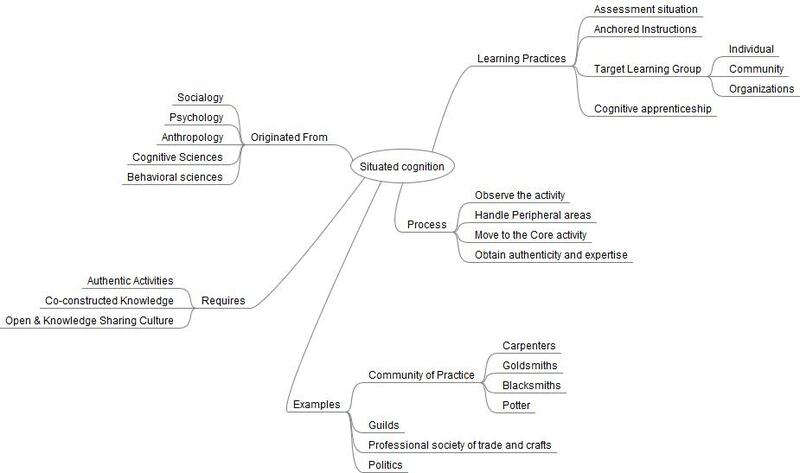e-Learning Ecologies MOOC’s Updates
Situated Cognition
Situated Cognition
Introduction
Situated cognition is a field of study which emphasizes learning from situatedness, environment, people, and community. It gives high stress on setting and people. Situated Cognition is a multi-disciplinary field emerging from Anthropology, Sociology, Psychology, Behavioural Sciences, and Cognitive sciences. It recognizes learning as an emergent and social activity, rather than a mechanistic and individual activity.
In the 1980s several studies found out that students learn more through, active participation in practical activities by acquiring new skills, rather than engaging in classroom learning activities. Situated cognition further contradicts the earlier belief that learning is an individual-centric activity, driven by internal motivation, pursued independently. It lays stress on the need of expert practical guidance, open knowledge sharing culture, and a bigger role of communities in learning.
Components, Structure, and Process
The core components of Situated Cognition are:
- Knowledge acquisition through practical activities
- These practical activities are driven by the environment in which learner exists. Hence it leads to situatedness.
- Learning involves the community and relies on social networks within it.
[A close up of a map Description automatically generated]
In Situated Cognition, the learning is grounded in situations and environment along with other actors (People, Experts, Community) interacting with the learner increasing his /her cognitive capabilities in that situation. It gives the name of “Situated Cognition” to such a method of learning. I am enclosing a mindmap to show the process, environment, requirements, and outcomes of Situated Cognition. In it, people learn from interacting with each other through shared activities and language knowledge sharing.
Situated Cognition leads to various structure expert in providing learning environments, such as “Community of Practice”. It is a group of people who show skill, passion, and concern for something they do and practice on improving it through mutual interactions. Historical Guilds and Present Professional Societies like ACM, IEEE can be thought of as a community of practice involved in Situated learning.
Advantages of Situated Cognition
1. Higher engagement among participants, giving more meaning to the learning being acquired.
2. The value of learning lies in necessity. It is having a higher correlation with employment.
3. It is more efficient to handle unstructured problems which are over 90% of actual problems.
4. It is skill-oriented rather than knowledge oriented.
Disadvantages of Situated Cognition
1. Not feasible for institution-based learning due to time constraints.
2. Experts tend to be secretive and do not interact much with each other.
3. It requires an open knowledge sharing culture, which may not be present in several communities.
References:
Gallagher, S., Robbins, B.D., & Bradatan, C. (2007). Special issue on the situated body. Janus Head: Journal of Interdisciplinary Studies in Literature, Continental Philosophy, Phenomenological Psychology, and the Arts, 9(2). URL: http://www.janushead.org/9-2/
Gee, J. P. (2004). Situated Language and learning: A critique of traditional schooling. London: Routledge.
Gee, J. P. (2007). Good video games and good learning: Collected essays on video games, learning, and literacy. New York: Lang.
Gee, J. P. (2010). A Situated-Sociocultural Approach to Literacy and Technology. In E. Baker (Ed.), The New Literacies: Multiple Perspectives on Research and Practice, pp. 165–193. New York: Guilford Press.


